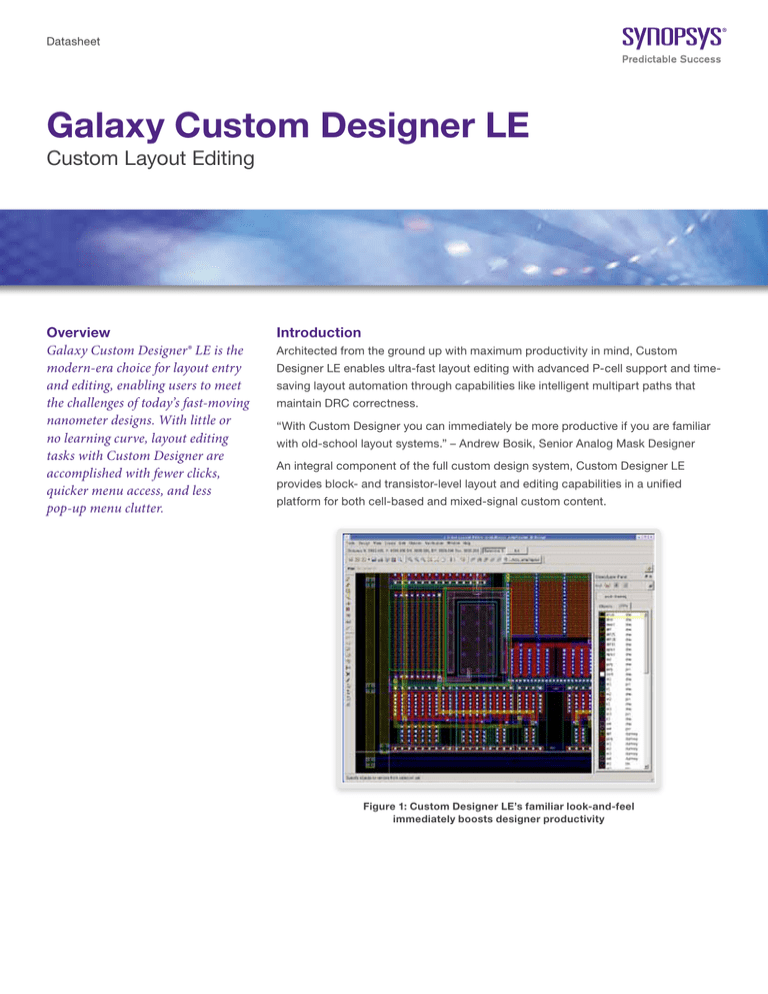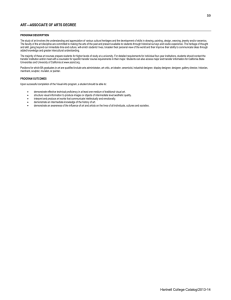
Datasheet
Galaxy Custom Designer LE
Custom Layout Editing
Overview
Galaxy Custom Designer® LE is the
modern-era choice for layout entry
and editing, enabling users to meet
the challenges of today’s fast-moving
nanometer designs. With little or
no learning curve, layout editing
tasks with Custom Designer are
accomplished with fewer clicks,
quicker menu access, and less
pop-up menu clutter.
Introduction
Architected from the ground up with maximum productivity in mind, Custom
Designer LE enables ultra-fast layout editing with advanced P-cell support and timesaving layout automation through capabilities like intelligent multipart paths that
maintain DRC correctness.
“With Custom Designer you can immediately be more productive if you are familiar
with old-school layout systems.” – Andrew Bosik, Senior Analog Mask Designer
An integral component of the full custom design system, Custom Designer LE
provides block- and transistor-level layout and editing capabilities in a unified
platform for both cell-based and mixed-signal custom content.
Figure 1: Custom Designer LE’s familiar look-and-feel
immediately boosts designer productivity
Key Benefits
``
One unified platform for both cellbased and custom content speeds
complex chip design and integration
tasks
``
Supports Synopsys’ IC Validator,
Hercules™ DRC/LVS and StarRC™
flows for industry signoff physical
verification
``
Supports the IPL Alliance’s
Interoperable PDK (iPDK) libraries for
industry-wide design data sharing
``
Provides multiple-layer purpose-pair
browsers in a single session when
editing designs in multiple libraries
``
Powerful, interactive layout automation
tools accelerate design completion
Figure 2: Custom Designer’s tight integration between schematic, layout and Custom
WaveView speeds design analysis and debug
through near-DRC clean layout,
making post-DRC fixing a trivial task
Extending the Galaxy
Implementation Platform
As semiconductor designs demand more
custom and analog/mixed-signal (AMS)
content, custom design teams need new
ways to address the challenge of quickly
and efficiently integrating into existing
digital design flows.
quickly perform physical verification and
supports P-cell abutment when editing or
extraction.
placing cells in batch mode. Scripts can
The native integration between Custom
be used for batch-mode processing to
Designer SE, Custom Designer LE and
create or edit layouts, and abutment will
StarRC provides a complete round-trip
be triggered correctly.
parasitic resimulation flow complete with
Custom Designer LE also fully supports
back-annotation. The comprehensive
stretch handles that allow fast on-canvas
flow ensures the highest-possible
manipulation of P-cells through graphical
accuracy in parasitics extracted from the
means. Users can drag a stretch handle
physical design.
and change the layout of a P-cell quickly,
Custom Designer leverages the powerful
in context with the surrounding objects.
Implementation Platform to provide a
Advanced P-cells Speed
Layout Editing
unified solution for custom and digital
Custom Designer’s real-time preview
Interoperable PDK Libraries from
design teams. Digital teams now have
of P-cell parameter changes shows the
the IPL Alliance, an industry-wide
access to a unified, comprehensive AMS
results before committing to placement.
collaborative effort to create and promote
block authoring flow with an optimized
Designers instantly see the results of
interoperable process design kit (iPDK)
pipeline that eliminates tedious data
their changes and can quickly adapt
standards, can also be used with Custom
exchange and leads to final designs in
the design to significantly speed up the
Designer. IPL standards enable a single
shorter time.
layout editing process.
PDK to be used by any OpenAccess tool,
Custom Designer supports P-cells
thus reducing PDK development and
capabilities of Synopsys’ Galaxy™
A Unified Flow with Common
Use Model Delivers Fastest
Time to Results
Custom Designer LE provides a unified
written in TCL, Python and C++, any of
which can be freely mixed in the same
design.
flow based in a common use model,
P-cell callbacks in Custom Designer
allowing seamless access to Synopsys’
LE are also triggered during scripting,
Hercules for LVS/DRC and StarRC for
helping to eliminate synchronization
parasitic extraction. Designers simply
problems in designs. This capability also
Interoperable PDK Libraries
support costs, lowering integration costs
and, for the first time, allowing choices
in tool selection when building analog/
custom IC design flows.
run Hercules or StarRC as part of
the Custom Designer environment to
Galaxy Custom Designer LE
2
Time-Saving Automation in
Layout
The Automatic Guardring Generator
gives the user the ability to create
conforming and rectilinear guardrings
in real-time. These guardrings are also
known as Multi-Part Paths (MPPs). They
can be quickly generated with a userspecified separation around a selected
set of layout objects. The guardrings are
connectivity aware and can be further
manipulated via the “Stretch” “Reshape”
and “Chop” commands.
Custom Designer’s connectivity driven
automatic via insertion feature places
DRC-correct vias or via arrays between
layers whose net names match. This
Figure 3: Bus routing with automatic via up/down and via templates
feature runs in real-time to quickly and
A high-performance interactive bus
to specify the locations to rapidly form
accurately complete the layout wiring.
routing feature allows users to digitize
a bridge (via up) or a tunnel (via down),
The use model works in a simple point
multiple bus bits simultaneously. The
allowing routes to pass under a given
and click mode for inserting vias one at
bus router automates via up and down
bus or net. Designers are no longer
a time, or by a window region where vias
functions using a variety of via pattern
required to manually chop the wires
are inserted in all applicable areas. The
choices. (See Figure 3.)
and manually insert vias. This reduces
Align Assist displays interactive
the potential of creating costly DRC
function also works down through the
layout hierarchy.
alignment markers that help guide the
violations and avoids the tedious time it
An Auto Connect feature allows high-
user to correct alignment, allowing more
takes to correct them. (See Figure 4.)
altitude wiring hookups that snap to pins,
work to be performed at the high altitude.
Shadow mode is a unique highlight
source, drain and gate connections,
This function works with all objects on
mechanism allowing the user to highlight
reducing the need to zoom in/out to
the drawing canvas.
nets in their true respective colors, while
Custom Designer’s Bridge and Tunnel
dimming the background. The Shadow
ensure a correct connection that is
on grid. Using this feature, designers
achieve higher productivity through fewer
mouse clicks.
command allows the designer to use a
window or a digitized rectilinear shape
Mode function also has a dimmer
control to set the brightness of the
shadowed background. (See Figure 5)
Figure 4: The Tunnel and Bridge command used to clear a routing path underneath a bus showing the bus
before (left) and the bridge after
Galaxy Custom Designer LE
3
SmartDRD: Innovative DesignRule-Driven Technology
Custom Designer LE employs new
advanced capabilities to assist with
DRC correct editing. This technology is
commonly known as Design Rule Driven
(DRD) editing. SmartDRD addresses—in
real-time—DRC for both mainstream and
advanced semiconductor processes with
3 high-performance features:
``
DRDVisual
``
DRDAssist
``
DRDAutoFix
DRDVisual concurrently checks
Figure 5: Shadow mode enabled for selected net
hundreds of rules, including tablebased, and provides visual feedback in
real time (See Figure 6).
DRDAssist enables layout designers
to perform DRC correct layout tasks
at zoomed-out “high altitude”, greatly
reducing the number of zooming-in and
zooming-out iterations. DRDAssist will
ensure DRC correctness by keeping
objects separated at the minimum design
rule distance, in-real time. DRDAssist
“push through” technology provides a
flexible use model by allowing the layout
designer to override a design rule violation
at anytime just by pushing the cursor
through the violation when desired. The
repelling function is temporally disabled
and then re-enabled to check for the next
violation as the designer continues to
work. The layout designer is in complete
control and the sensitivity threshold for
“push through” is user controllable.
DRDAutoFix (Figure 7) employs
automatic DRC violation detection and
correction that will help greatly reduce
the tasks of manually repairing DRC
violations which can take more than
40% of the overall layout design cycle
time. This new technology provides a
powerful productivity boost in custom
layout. It uses minimum perturbation
algorithms to repair DRC violations as
one would do by hand and employs a
simple point ­and-click use model.
Galaxy Custom Designer LE
Figure 6: Design Rule Driven layout with DRDVisual
Open, Interoperable and
Extensible Environment
and development, including access to
Based on Si2’s OpenAccess database
Custom Designer’s open infrastructure
and extensible through the industry-
also provides the ability to develop
standard TcL scripting language,
consistent user interfaces across
Custom Designer’s open environment
the Custom Designer environment
allows CAD groups to quickly add new
by providing access to standard
tools to the environment.
components like menus and tool bar
Custom Designer’s open infrastructure
icons.
is a shift in the EDA industry, offering
Custom Designer’s open environment
unfettered access to your design
also includes a Programmable Netlister
data. With no proprietary languages,
that ships with open-source code,
databases or extensions, Custom
allowing quick implementation of custom
Designer offers CAD groups deep
netlist formats including extracted views.
visibility into the system’s design
The netlister supports CDF parameters,
infrastructure, enabling high-
including PEL/AEL expressions, CDF
performance application integration
“simInfo” and netlisting.
in-memory data and runtime objects.
4
DRDAutoFix corrects violations in seconds
Example with multiple rule violations
DRC clean after DRDAutoFix
Figure 7: Custom Designer’s DRDAutoFix layout productivity feature showing spacing violations before (left) and after correction
Powerful Capabilities Shared
Across Custom Designer
Environment
Custom Designer’s “Transaction
Custom Designer boasts a single
History” is a sophisticated undo/redo
job monitor that logs all batch and
system that records all data creation
interactive jobs launched from any native
Powerful new GUI technologies provide
and manipulation commands during
Custom Designer tool or any other
the entire Custom Designer system
an editing session for schematics and
tool integrated into the environment.
with a unique set of capabilities that are
layout. Recallable at any time, this
Job status is saved across different
shared across all components.
history is also unique to each different
sessions. Additionally, the Job Monitor
cell view, improving the designer’s recall
can manage jobs submitted to both
of the editing steps.
Sun Microsystems’ Sun Grid Engine
tool and shares the same use model
All Custom Designer commands are
and Platform Computing’s LSF load-
used in all user subsystems.
logged in a log file (.log and .tcl) and
Custom Designer has extensive contextsensitive menu support throughout the
Custom Designer’s property editor
allows for single or mass editing of
property values across selected
can be replayed in the tool. This can be
beneficial when creating macros for any
task that needs to be repeated.
instances. Tabbed views simplify editing
Icons for recently used commands
of different device types and “As-Is”
appear on the history toolbar. Re-
technology clearly indicates mismatches
invoking previously used commands is
in values.
easy. Custom Designer also supports
balancing products.
Platform Support
``
X86 for 32- and 64-bit
``
Red Hat Enterprise Linux version 4
and 5 (AS, ES, WS)
``
SUSE Linux 10 and 11 (AS, ES, WS)
standard and user-definable bind-key
sets, allowing you to customize the
system to meet your unique design style.
Synopsys, Inc. 700 East Middlefield Road Mountain View, CA 94043 www.synopsys.com
©2010 Synopsys, Inc. All rights reserved. Synopsys is a trademark of Synopsys, Inc. in the United States and other countries. A list of Synopsys trademarks is
available at http://www.synopsys.com/copyright.html. All other names mentioned herein are trademarks or registered trademarks of their respective owners.
09/10.CE.10-19186.


